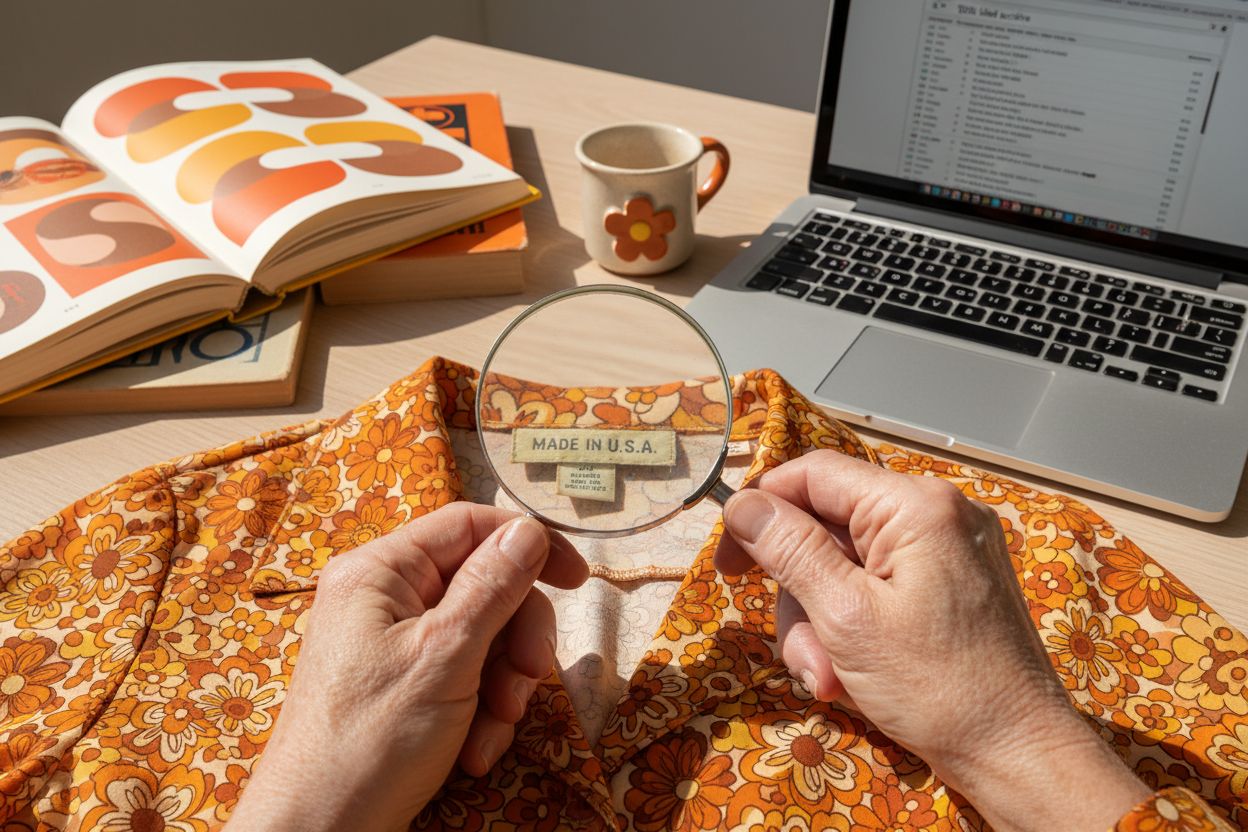How to Identify Vintage Clothing with Confidence and Ease
- Emma
- Oct 15
- 8 min read

Did you know that genuine vintage clothing can sometimes increase in value by more than 50 percent over just a few years? Finding and identifying authentic pieces is not just a hobby but a way to connect with fashion history and spot valuable treasures others might miss. With the right research tools and sharp detective skills, you can uncover clothing that holds both charm and investment potential.
Quick Summary
Key Point | Explanation |
1. Gather essential research tools | Assemble fashion history books, digital archives, and reputable websites for effective vintage identification. |
2. Analyze labels for authenticity | Examine labels for outdated country names and absence of modern care tags to gauge age and authenticity. |
3. Inspect fabric and construction quality | Focus on natural fibers and superior weaving techniques to distinguish authentic items from reproductions. |
4. Understand historical style trends | Familiarize yourself with unique fashion traits from each era to enhance identification skills. |
5. Verify authenticity with provenance | Look for age markers and original documentation to substantiate the historical value and authenticity of garments. |
Table of Contents
Step 1: Gather Essential Tools and Reference Materials
Identifying authentic vintage clothing starts with building a solid foundation of knowledge and collecting the right research tools. Think of this step as your vintage fashion detective kit.
Start by assembling some critical reference materials that will become your trusted companions in your vintage clothing exploration. Your first mission is acquiring comprehensive fashion era guidebooks and historical style encyclopedias. According to the Vintage Fashion Guild, understanding era specific details like fabric composition, manufacturing techniques, and design nuances is crucial for accurate identification.
Your research toolkit should include several key resources:
• Comprehensive fashion history books covering styles from the 1920s through the 1990s • Online databases like the Trademark Electronic Search System (TESS) for verifying manufacturer labels • Digital archives of vintage clothing catalogues and fashion magazines • Reputable vintage fashion websites with detailed identification guides
Photographic references are particularly valuable. Collect visual documentation from different decades that showcase authentic clothing construction, typical fabric patterns, and signature design elements. This visual library will help train your eye to spot genuine vintage pieces quickly.
Here’s a summary of essential vintage research tools:
Resource Type | Description | Typical Uses |
Fashion History Books | Guides to styles 1920s–1990s | Identify era details Reference fabric and cuts |
Online Databases | e.g., TESS, label archives | Verify brand labels Check manufacturer history |
Digital Archives | Vintage catalogues, magazines | Cross-reference designs Study original adverts |
Reputable Websites | Fashion identification guides | Supplement research Access user tips and images |
Photographic References | Visuals by decade | Train eye for construction Spot authentic details |
Pro Tip: Create a dedicated digital folder or physical binder where you can compile research materials and reference images for easy access during your vintage hunting adventures.
By methodically gathering these tools, you are setting yourself up for successful vintage clothing identification. Your next step will involve learning how to apply this newfound knowledge when examining potential vintage finds.
Step 2: Analyse Labels, Tags, and Brand Signatures
Labels and tags are like secret time capsules that reveal the hidden history of a vintage garment. Learning how to decode these tiny textile markers will transform you from a casual vintage shopper into a true clothing detective.
Start by examining the label closely. According to research from the Talented Ladies Club, several key features can instantly help you determine a garment’s age and authenticity. Look for specific markers like outdated country names, half-size clothing markings, or the presence of union labels which often indicate clothing produced before the 1990s.
Copyright years printed on labels are particularly revealing. Vintage pieces might showcase copyright dates from earlier decades or feature manufacturing locations like ‘Made in USA’ that hint at the garment’s origin period. The absence of modern care tags is another strong indicator of vintage status.

Zip codes can also provide fascinating historical context. Older labels might feature three digit zip codes or regional indicators no longer used in contemporary clothing manufacturing. Read more about decoding vintage labels to become even more proficient in your detective work.
Pro Tip: Always use natural light and a magnifying glass when examining small labels to catch every minute detail.
By mastering these label analysis techniques, you are building a robust skill set that will serve you throughout your vintage clothing journey. Your next step involves understanding the nuanced world of fabric and construction details.
Step 3: Inspect Fabrics, Construction, and Fastenings
Every vintage piece tells a story through its fabric, construction, and intricate fastenings. Learning to read these textile narratives will help you distinguish authentic vintage treasures from modern reproductions.
According to research from the Trad Collective, fabric quality is the first critical indicator of a garment’s authenticity and craftsmanship. Natural fibres like cotton, wool, silk, and linen are hallmarks of genuine vintage pieces. These materials age more gracefully and develop a unique patina that synthetic fabrics simply cannot replicate.
Take time to examine the fabric’s weight and weave. Higher thread counts and heavier weaves often signify superior construction and durability. Run your fingers across the material feeling for texture and checking for any signs of wear. Vintage clothing should feel substantial yet retain its fundamental structural integrity.
Fastenings provide another crucial clue to a garment’s age and quality. Examine buttons carefully observe their material composition and attachment method. Vintage pieces frequently feature intricate button designs crafted from materials like bakelite, mother of pearl, or unique metal configurations that differ markedly from contemporary mass produced alternatives. Explore our guide to vintage clothing construction for more detailed insights.
Pro Tip: Zippers and hooks can also reveal a garment’s era. Older metal zippers often have distinct manufacturing characteristics compared to modern plastic alternatives.
By developing a keen eye for fabric nuances and construction details, you are building expertise that transforms vintage clothing shopping from a casual hobby into an informed passion.
Your next step involves understanding how to assess a garment’s overall condition and potential restoration needs.
Step 4: Compare Styles and Prints to Historical Trends
Mastering the art of vintage clothing identification requires developing a keen understanding of fashion history. Think of yourself as a visual historian who can trace clothing evolution through distinctive design elements and iconic styles.
According to research from Vintage UK, each fashion era possesses unique characteristics that set it apart. The 1970s, for instance, celebrated bold synthetic fabrics and vibrant geometric prints while the 1940s emphasized structured silhouettes and natural fibres. Learning to distinguish these defining traits will dramatically improve your vintage identification skills.
Start by immersing yourself in visual references. Explore the history behind popular vintage patterns to understand how design motifs evolved across decades. Pay attention to distinctive features like bell bottom widths in 1970s trousers, shoulder pad structures in 1980s blazers, or waistline placements in different eras.
Research from Zipsale suggests staying current with contemporary vintage trends can also enhance your expertise. While recognising historical accuracy is crucial, understanding current market demand for specific era styles provides valuable context.
Pro Tip: Create a visual reference board showcasing characteristic prints, cuts, and design elements from different decades to train your eye effectively.
By developing this nuanced understanding of historical fashion trends, you are transforming yourself from a casual vintage enthusiast into a knowledgeable collector. Your next step involves learning how to authenticate your potential vintage finds through comprehensive research and expert techniques.
Step 5: Verify Authenticity Using Age Markers and Provenance
Authenticity is the heartbeat of vintage clothing collecting. Your detective work now shifts to piecing together a garment’s historical puzzle using subtle yet powerful evidence.
According to research from the Talented Ladies Club, multiple age-specific markers can decisively confirm a piece’s vintage status. Look for telltale signs like the complete absence of care instructions (indicating pre-1971 production), outdated zip codes (pre-1963), or country names that no longer exist on modern maps.
Provenance becomes your next crucial investigation. As insights from Zipsale suggest, understanding an item’s background and original ownership can dramatically enhance its authentication. Original labels, seller documentation, and traceable ownership history transform a simple garment into a documented historical artifact.
Explore our comprehensive guide to vintage clothing authentication to deepen your investigative skills. Cross-referencing physical age markers with documented provenance creates an unassailable case for a piece’s authenticity.
Pro Tip: Collect and preserve any original documentation accompanying a vintage piece. These seemingly small details can significantly increase both its historical value and potential collector interest.
By meticulously examining these nuanced authentication markers, you are elevating yourself from a casual vintage enthusiast to a true textile historian. Your next step involves understanding how to responsibly care for and preserve your newfound vintage treasures.
Take the Guesswork Out of Vintage Shopping – Shop Authentically with My Vintage
You have just learned the secrets to identifying true vintage clothing including how to spot authentic labels, analyse era-specific fabrics, and decode subtle age markers. Yet even with new-found skills, you might still worry about making mistakes or missing out on genuine, high-quality finds. That feeling of doubt and uncertainty is common, especially when time and money are on the line.
At My Vintage, your search for authentic and expertly curated vintage clothing becomes effortless. Why spend hours second-guessing your knowledge? Every piece on our site is handpicked by vintage specialists who apply many of the identification techniques you have just read about. With detailed images, comprehensive descriptions, and clear historical context, you can shop with complete peace of mind. Our collection covers authentic clothing and accessories from the 1940s to the 1990s so you always find something unique and significant.

Ready to put your new skills into practice and secure a truly one-of-a-kind treasure? Browse our range at My Vintage now. Discover pieces already verified for their history, quality, and individuality. Do not wait – the most desirable finds are snapped up fast, and authentic vintage is always in demand. Experience the confidence and satisfaction of shopping with the UK’s trusted vintage experts today.
Frequently Asked Questions
How can I identify the age of a vintage clothing piece?
To identify the age of vintage clothing, examine labels for markers such as outdated country names or copyright dates. Check for features like union labels, which can indicate production before the 1990s.
What are the best practices for analyzing fabric in vintage clothing?
Focus on the type of fibres used; natural fabrics like cotton, wool, and silk are generally indicators of authenticity. Feel the fabric’s weight and weave for quality, and note any unique textures or patterns that are typical of specific eras.
How can I confirm the authenticity of a vintage piece?
Verify authenticity by checking for age-specific markers like the absence of care instructions or outdated zip codes. Additionally, research the garment’s provenance through original labels or documentation if available to establish its historical background.
What should I look for in labels and tags when identifying vintage clothing?
Pay close attention to the label’s details; look for half-size markings or old brand names. Check for copyright years, as earlier dates can indicate a vintage garment—this will help you age and authenticate the piece effectively.
How do I differentiate between genuine vintage clothing and modern reproductions?
To differentiate genuine vintage items from reproductions, closely inspect the materials and construction techniques. Authentic vintage garments often have distinctive features like unique fastenings and higher-quality fabrics that are uncommon in modern fast fashion.
What resources can help me learn more about vintage clothing styles?
Use comprehensive fashion history books or online databases that cover different fashion eras as valuable resources. Create a visual reference board with characteristic designs to strengthen your understanding of historical trends in clothing styles.
Recommended





